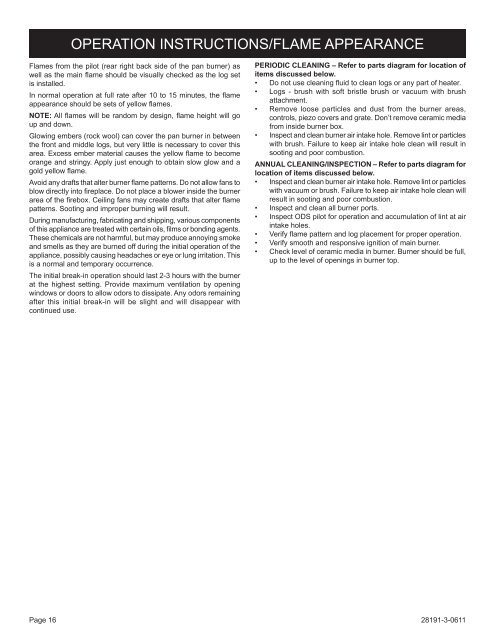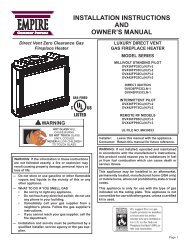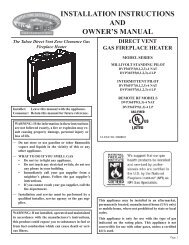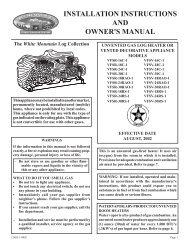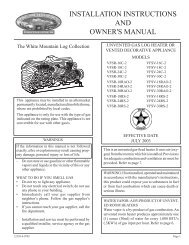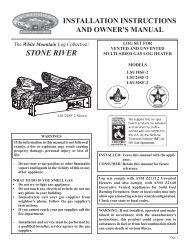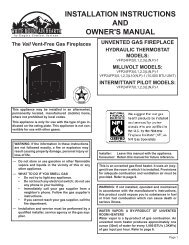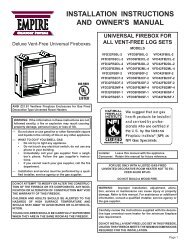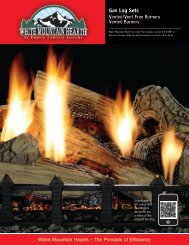Vail Premium Vent-Free Fireplace Manual - White Mountain Hearth
Vail Premium Vent-Free Fireplace Manual - White Mountain Hearth
Vail Premium Vent-Free Fireplace Manual - White Mountain Hearth
You also want an ePaper? Increase the reach of your titles
YUMPU automatically turns print PDFs into web optimized ePapers that Google loves.
Page 16<br />
OPERATION INSTRUCTIONS/FLAME APPEARANCE<br />
Flames from the pilot (rear right back side of the pan burner) as<br />
well as the main flame should be visually checked as the log set<br />
is installed.<br />
In normal operation at full rate after 10 to 15 minutes, the flame<br />
appearance should be sets of yellow flames.<br />
NOTE: All flames will be random by design, flame height will go<br />
up and down.<br />
Glowing embers (rock wool) can cover the pan burner in between<br />
the front and middle logs, but very little is necessary to cover this<br />
area. Excess ember material causes the yellow flame to become<br />
orange and stringy. Apply just enough to obtain slow glow and a<br />
gold yellow flame.<br />
Avoid any drafts that alter burner flame patterns. Do not allow fans to<br />
blow directly into fireplace. Do not place a blower inside the burner<br />
area of the firebox. Ceiling fans may create drafts that alter flame<br />
patterns. Sooting and improper burning will result.<br />
During manufacturing, fabricating and shipping, various components<br />
of this appliance are treated with certain oils, films or bonding agents.<br />
These chemicals are not harmful, but may produce annoying smoke<br />
and smells as they are burned off during the initial operation of the<br />
appliance, possibly causing headaches or eye or lung irritation. This<br />
is a normal and temporary occurrence.<br />
The initial break-in operation should last 2-3 hours with the burner<br />
at the highest setting. Provide maximum ventilation by opening<br />
windows or doors to allow odors to dissipate. Any odors remaining<br />
after this initial break-in will be slight and will disappear with<br />
continued use.<br />
PERIODIC CLEANING – Refer to parts diagram for location of<br />
items discussed below.<br />
• Do not use cleaning fluid to clean logs or any part of heater.<br />
• Logs - brush with soft bristle brush or vacuum with brush<br />
attachment.<br />
• Remove loose particles and dust from the burner areas,<br />
controls, piezo covers and grate. Don’t remove ceramic media<br />
from inside burner box.<br />
• Inspect and clean burner air intake hole. Remove lint or particles<br />
with brush. Failure to keep air intake hole clean will result in<br />
sooting and poor combustion.<br />
ANNUAL CLEANING/INSPECTION – Refer to parts diagram for<br />
location of items discussed below.<br />
• Inspect and clean burner air intake hole. Remove lint or particles<br />
with vacuum or brush. Failure to keep air intake hole clean will<br />
result in sooting and poor combustion.<br />
• Inspect and clean all burner ports.<br />
• Inspect ODS pilot for operation and accumulation of lint at air<br />
intake holes.<br />
• Verify flame pattern and log placement for proper operation.<br />
• Verify smooth and responsive ignition of main burner.<br />
• Check level of ceramic media in burner. Burner should be full,<br />
up to the level of openings in burner top.<br />
28191-3-0611


